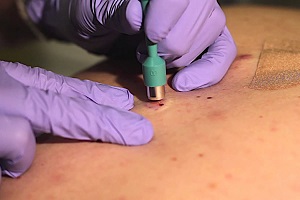A biopsy is a medical procedure in which a small sample of tissue or cells is taken from the body for further examination and analysis. It is commonly performed to diagnose or determine the nature of a suspected abnormality or disease. Biopsies can be conducted on various parts of the body, including the skin, organs, or specific areas of concern.
Here’s a general overview of the biopsy procedure:
- Preparation: Before the biopsy, your healthcare provider will explain the procedure to you and answer any questions you may have. They will also review your medical history and any medications you are taking. In some cases, you may need to temporarily discontinue certain medications or follow specific instructions regarding fasting or other preparations.
- Local Anesthesia: Depending on the type of biopsy and the area being sampled, a local anesthetic may be administered to numb the area and minimize discomfort during the procedure. In some cases, sedation or general anesthesia may be used.
- Biopsy Technique: There are different biopsy techniques depending on the area being sampled and the suspected condition. Common biopsy methods include:
- Needle Biopsy: A thin needle is inserted into the area of concern to extract a small tissue or fluid sample. This can be done under imaging guidance, such as ultrasound or CT scan, for precise targeting.
- Incisional Biopsy: A small incision is made to remove a portion of the tissue for examination. This type of biopsy is often performed when a larger sample is needed or for lesions that cannot be easily accessed by a needle biopsy.
- Excisional Biopsy: This involves the surgical removal of an entire abnormality or suspicious lesion, such as a mole or tumor, along with a margin of healthy tissue surrounding it.
- Endoscopic Biopsy: A specialized tube with a camera and tools is inserted into the body through natural openings or small incisions to collect samples from internal organs or tissues.
- Sample Collection: The healthcare provider will carefully collect the tissue or fluid sample using the chosen biopsy technique. In some cases, stitches may be required to close the incision site.
- Post-Biopsy Care: After the procedure, the sample is sent to a laboratory for analysis by a pathologist. The results are typically available within a few days to weeks, depending on the complexity of the analysis. Your healthcare provider will discuss the results with you and determine the appropriate next steps based on the findings.
Biopsies are valuable diagnostic tools that can provide important information for the diagnosis and treatment of various medical conditions, such as cancer, infections, inflammatory diseases, and more. It’s essential to follow the post-biopsy instructions provided by your healthcare provider and attend any necessary follow-up appointments for further evaluation and management.

